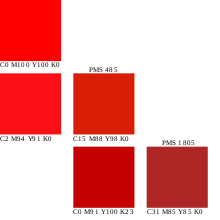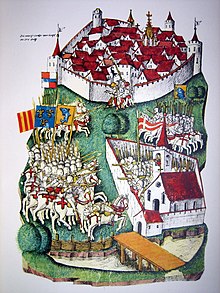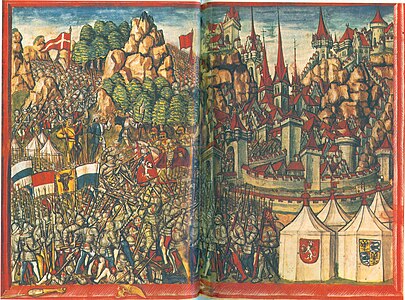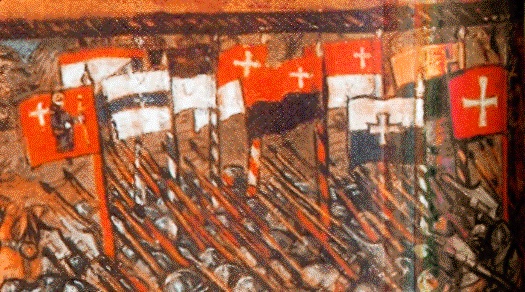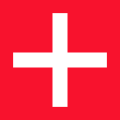Flag and coat of arms of Switzerland
| Swiss flag | |
|---|---|
 |
|
| Vexillological symbol : |
|
| Aspect ratio: | 1: 1 |
| Officially accepted: | December 12, 1889, square shape: June 21, 2013 |
The Swiss flag and the coat of arms of Switzerland show an upright, free-standing white Greek cross on a red background - the Swiss cross .
Swiss flag
In Switzerland , the designation flag is not used. The name in Swiss High German is instead flag or Swiss flag .
Proportions
In contrast to most other national flags, the Swiss flag is square . In addition, a square shape is often given for the flag of the Vatican State, but this is controversial. The Swiss flag was generally used in a square shape long before it was legally stipulated. The new law on the protection of coats of arms has been in force since January 1, 2017, which prescribes the square shape in Art. 3 : "The Swiss flag shows a Swiss cross in a square field." A rectangular flag with a ratio of 2: 3 flies only on ocean-going and inland vessels operated by Swiss shipping companies (see below). This exception was confirmed in the Coat of Arms Protection Act ( Art. 3 Para. 3 WSchG).
For the Swiss cross, “the arms are each one sixth longer than wide” ( Art. 1 1 WSchG). The ratio of width and length is therefore 6 to 7 for the cross arms and 6 to 20 for the entire cross bars.
The size of the Swiss cross in relation to the flag is determined in Appendix 2 of the Coat of Arms Protection Act using a drawing: The distance between the cross and the edge of the flag is one bar width on each side. The ratio of the length of the crossbars to the total side length of the flag is therefore 5 to 8.
Swiss flag at sea
Since April 17, 1941, Swiss seagoing ships have been flying a rectangular national flag with a ratio of 2: 3, which is known as the “Swiss flag at sea”. According to the law, it may only be carried by seagoing vessels registered in Switzerland ( Art. 3 Maritime Law). The flag is defined in Appendix 1 of the Federal Act of 23 September 1953 on Maritime Shipping under the Swiss Flag.
To the Engineer Corps counting patrol boats of Motor Boat Company of the Swiss Armed Forces perform the Swiss flag at sea. There is no marine .
A rectangular Swiss flag was introduced for ships on Lake Constance as early as 1911 . In their instructions for the operation of Lake Constance steamship from January 15, 1911, the shipping inspection of the Swiss Federal Railways in Romanshorn laid down the flag order for their ships, according to which "the stern and bow flags are rectangular in a ratio of 2: 3". With the flag order of May 20, 1951, Lake Constance ships carry the flag hoisted at the stern in a rectangular shape.
Swiss coat of arms
The federal coat of arms contains the same colors and the same cross as the flag: a free-standing, white cross on a red background, the four arms of which are "one sixth longer than wide". This was already determined by a federal decree of December 12, 1889. A sample drawing of the coat of arms was attached to the text, but this was not declared authoritative, so that the shape of the coat of arms and the size of the cross in relation to the coat of arms were not yet defined. On the other hand, Article 2 of the Coat of Arms Protection Act, which has been in force since 2017, states : "The pattern shown in Appendix 1 is authoritative for shape, color and proportions." It is the same sample drawing that was attached in 1889, with the difference that it is now binding. This defines the shape of the coat of arms and the size of the cross within the coat of arms.
Representations of the coat of arms, with varying forms of the coat of arms shield, can be found on Swiss coins , on SBB locomotives such as the Re 420 series , on the license plates of cars and on some municipal coats of arms , for example in Langendorf SO . The coat of arms is also applied to some consumer goods - or a logo that is similar to the Swiss coat of arms , for example that of Victorinox on Swiss army knives .
The Swiss red
The color of the red background on the flag and coat of arms was not legally defined before the introduction of the Coat of Arms Protection Act (WSchG); different shades of color have traditionally been used. Companies with logos derived from the coat of arms also use different shades. The Swiss logo is darker than the red in the Swissair logo at the time . Today's Victorinox logo has a different color and is significantly darker than, for example, the red in the SIGG logo .
In individual cantons that have red in their coat of arms, the color was not defined and simply referred to as "coat of arms red". In other cantons it was determined differently, e.g. B. as Pantone 032 (Solothurn, Bern and Schwyz) or Pantone 3G (Obwalden). In heraldry, the Helvetic red is indicated in the printing color Pantone 032 C.
The corporate design of the federal administration, which came into force in 2007, defined the “Swiss red” as Pantone 485, that is, composed of 100 percent magenta and yellow . Red with the RGB value # FF0000 was recommended for displaying on the Internet with so-called " web-safe colors " (a color palette from the early days of the Internet) .
In a corporate identity manual of the Federal Department of Foreign Affairs from 2008, the color for publications of the organizational unit Presence Switzerland was determined as follows.
| Full color printing | 4-color printing | Screen / web | ||
|---|---|---|---|---|
| Pantone | CMYK | RGB | HEX | Color sample |
| 1797 C / 1797 U | 0/100/95/5 | 225/26/39 | # E11A27 | |
The Federal Act on the Protection of the Swiss Coat of Arms and Other Public Signs (Coat of Arms Protection Act) of June 21, 2013 has been in force since 2017. In Appendix 1 , the red of the Swiss coat of arms and the Swiss flag is defined as follows:
| Full color printing | 4-color printing | Screen / web | ||
|---|---|---|---|---|
| Pantone | CMYK | RGB | HEX | Color sample |
| 485 C / 485 U | 0/100/100/0 | 255/0/0 | # FF0000 | |
history
Old Confederation until 1798


The origin of the Swiss cross is unclear. One of several interpretations brings it in connection with the legendary Thebaic Legion .
The Swiss cross has been from the old Confederates as ensigns used. At the Battle of Laupen in 1339, white crosses made of canvas strips were attached to the warriors' robes as identification marks. According to the Bern Chronicle by Konrad Justinger (1420), all Swiss fighters at the Battle of Laupen were "marked with the sign of Saint Crütz, a white Crütz in a red scold". This is the earliest documented use of the Swiss cross as a field symbol.
From the 14th century the white cross was used on the Bern standard, and in the 15th century it was also used on the other federal standard, the so-called flag. The flags were only used instead of the banners for less important campaigns. The only official emblems of the Old Confederation were the coats of arms of the cantons . The flags therefore continued to show the coats of arms of the cantons, at best a white cross was attached. Between 1450 and 1520 the white cross developed into the national identification symbol of the Confederates, especially in contrast to the Burgundian St. Andrew's Cross of the German mercenaries. The arms of the cross were narrow in this early period and often drawn right through to the edge, as in the Scandinavian flags. At that time, the white cross could appear on a red or another colored background, both on the flags and on the clothing of the fighters. The red background resulted from flags with the color red, especially the flag of the Canton of Schwyz .
The large flags as common federal standard could also have a triangular shape. The first pictorial representations of the Swiss cross as a flag can be found in the Lucerne Chronicle of 1513. The oldest representation of the Swiss coat of arms goes back to Johannes Stumpf's coat of arms from the middle of the 16th century. Since around this time the white cross has been known as the “federal cross”.
- ???
Large triangular Swiss flag (top left) in the Battle of Arbedo in 1422. The Confederates march under the flags of their cantons, but the white cross on their clothing, partly on a red background. Lucerne Chronicle (1513).
Swiss crosses on the flags of the Confederates in the Battle of Nancy in 1477. In addition to the flags of the Eight Old Places , there are those of Freiburg and Solothurn that only joined the Confederation four years later. The heraldic animal is missing on the flags of Bern and Uri . On the far right is the Schwyz flag . Representation in the Lucerne Chronicle (excerpt).
After the end of the Common Confederation Wars in 1515, the Swiss mercenary troops fighting abroad for foreign powers led in their standards and flags, which shared the white cross. The colors and patterns in the four squares were very different. The fields were either all or partly horizontally or vertically divided, often in variants with wavy or zigzag bars and diamonds. The colors of the flags corresponded to those of the captains.
In the second half of the 17th century, the regiments serving abroad as well as in the cantons saw the typical flame pattern of Swiss military flags. First the flames are arranged diagonally and interlock, then they are arranged radially and taper towards the inner cross angles.
Early form of the Swiss flag: the flag of Schwyz in the battle of Nancy in 1477 according to the Lucerne Chronicle (picture above)
Flamed flag of the French Swiss Guard (1721)
Helvetic Republic and Confederation until 1847

The first national flag existed during the Helvetic Republic 1798–1803. It was a green-red-yellow tricolor based on the French model, which was officially introduced on February 13, 1799.
In 1815 the cross became the official Swiss coat of arms . At first it was only used in the Swiss seal . However, as a sign of membership of the federal army, the cantonal troops wore a three-inch-wide armband with the white Swiss cross on a red background on the order of General Niklaus Franz von Bachmann since July 3, 1815 . In 1815 the free-floating Swiss cross appeared on the federal battalion flags for the first time. However, the cantonal contingents continued to have their own flags, which, as before 1798, only had the continuous white Swiss cross as a common feature.
At the endeavor of Guillaume-Henri Dufour , the federal infantry battalions received uniform flags by resolution of the Diet of September 2, 1839, which were to show a white cross on a red background with the name of the canton in gold on the crossbar of the cross arm. After further deliberations, the Diet adopted the new federal flag on July 21, 1840. In an initial circular to the cantons, there was talk of a red flag, which is cut through by the white cross. Only after further deliberations was it agreed on the form that is still valid today, which was communicated to the cantons in a circular on October 11, 1841 , based on a draft by Carl Stauffer .
Modern Switzerland after 1848
The federal military flag was adopted by the newly founded federal state in 1848. Dufour's Swiss cross was composed of five squares and differed significantly from the slender cross previously used. In 1889, in a federal decree of December 12th , the Federal Assembly established the shape of the Swiss cross, which is still valid today: “The Swiss coat of arms is an upright, free-standing white cross in the red field, the arms of which are each one sixth longer than wide ». A petition in 1890 asking for a return to the five-square cross was unsuccessful.
With regard to the flag, there was no definition, so the Swiss cross was simply taken from the coat of arms. The size of the Swiss cross in relation to the flag had not yet been determined. Flamed military flags were still in use by the Landwehr until around 1865.
Traditionally, the Swiss flag is used privately for decoration, especially on the Swiss National Day , and is sometimes hoisted throughout the year. During the 1980s, the use of the Swiss cross was often frowned upon as (too) nationalistic, but in the wake of the so-called Swissness it became a widely marketed symbol on souvenirs, clothing and design objects since the 1990s.
"Corporate Design Bund"
In November 2003, the Federal Council decided to create a unified and unambiguous image that was introduced on January 1, 2007. This appearance, known as the Corporate Design Bund or CD Bund for short , regulates the precise use of the federal coat of arms. The regulation applies to the Federal Council, the Federal Chancellery , the departments (see Federal Administration (Switzerland) ), the offices and all administrative units of the first and second district. The first circle comprises the central administration and the second circle the administrative units (VE), which are managed with a service mandate and global budget, the so-called FLAG units.
protection
The symbols of the Swiss Confederation are protected domestically by the federal law for the protection of public coats of arms and other public symbols (SR 232.21). As a rule, they may only be used as trademarks by the relevant official bodies. Under Section 125 of the Law on Administrative Offenses , the symbols of the Swiss Confederation - together with the symbols of the Red Cross - are also explicitly protected in Germany. The same applies in Austria, where there is a corresponding regulation in the Red Cross Act . The Netherlands also has a corresponding, punishable ban in its criminal code. The prohibitions are based on Article 53, Paragraph 2 of the 1st Geneva Convention . This standard obliges all contracting states to prohibit the use of the Swiss coat of arms by private individuals, companies and trading firms. The reason for this is, on the one hand, the risk of confusion with the Red Cross , which is also to be protected in this way, and , on the other hand, “the honor given to Switzerland by adopting the reversed federal national colors” as a trademark .
Similar symbols

Canton of Schwyz
The flag and coat of arms of the canton of Schwyz also show a white cross on a red background, but the white cross is much smaller and is in an upper corner. In addition, the arms of the cross are slimmer than those of today's Swiss cross.
House of Savoy
The coat of arms of the House of Savoy also shows a white cross on a red background. In contrast to the Swiss cross, the white cross extends to the edge of the shield on all sides, so that the red is divided into four separate areas.
Red Cross
The colored counterpart of the Swiss cross is the red cross on a white background. In honor of its founder Henry Dunant and his homeland, the Red Cross Organization chose this symbol as its trademark and protection.
See also
- List of coats of arms and flags of the Swiss cantons
- Municipality (Switzerland) #Lists of Swiss municipalities
- List of local coats of arms with the scallop shell in Switzerland
literature
- Elio Pellin, Elisabeth Ryter (Eds.): White on Red. The Swiss cross between national identity and corporate identity. Verlag Neue Zürcher Zeitung, Zurich 2004, ISBN 3-03823-111-8 .
- Peter M. Mäder, Günter Mattern: Flags and their symbols. = Drapeaux et leurs symboles. = Flags and their symbols (= Swiss National Museum. Illustrated book. 4). Swiss National Museum, Zurich 1993, ISBN 3-908025-24-9 .
- Louis Mühlemann: coat of arms and flags of Switzerland. 700 years / ans / anni / onns Confoederatio Helvetica. Official emblem and flag book for the 700th anniversary of the Confederation. Bühler, Lengnau 1991, ISBN 3-9520071-1-0 .
- Hanspeter Kindler The colors of Switzerland. What their flags reveal about the Confederates . Winterthur, 2015. ISBN 978-3-905752-44-1 .
Web links
- Peter F. Kopp: Swiss Cross. In: Historical Lexicon of Switzerland .
- Federal Act on the Protection of the Swiss Coat of Arms and Other Public Signs (Coat of Arms Protection Act, WSchG) of June 21, 2013 (as of January 1, 2017)
- Swiss cross and Swiss coat of arms Information from the Swiss Federal Institute for Intellectual Property
- Flags of the World - Switzerland (English)
- Georg Kreis : The Crux Helvetica. In: NZZ Folio . October 1998
Individual evidence
-
↑ Swiss Army (ed.): Dealing with flags, standards and fanions (flag regulations ) , regulations 51.340 d.
Quotation from section 4.1 (raising the Swiss flag): “In the command area of schools and troops, it is a tradition in many places to raise the Swiss flag in the morning and retract it in the evening. Because the flag is moved on a cable pull, it is actually a matter of raising and lowering the 'Swiss flag'. In our linguistic usage, the term Swiss flag has not become established in this sense. The regulations continue to speak of the Swiss flag. [...] The 'raising of a flag' will continue to be part of the everyday language in the army. " - ↑ According to information from the Apostolic Nunciature on the Vatican flag of May 27, 2010 to the German Federal Ministry of the Interior, the flag does not have a square shape. See also the flag of the Vatican City # aspect ratio .
- ↑ «The Swiss citizen identifies with square dimensions». In: Neue Zürcher Zeitung . August 16, 2008.
-
↑ a b Calculation of the length ratios (see sample drawing in Appendix 2 WSchG): Bar
width = 6 units, length of the arms = 7 units (since the arms of the cross are each one sixth longer than wide).
Entire length of the cross bar = arm length + beam width + arm length = 7 + 6 + 7 = 20,
distance from the edge = in each bar width = in each case 6
side length of the flag = distance + length of the cross-beam + Distance = 6 + 20 + 6 = 32.
aspect ratio Cross to flag = 20/32 = 5/8. - ↑ Flag Regulations of the Swiss Army
- ^ Louis Mühlemann: Coats of arms and flags of Switzerland. Zurich 1980, p. 27.
- ↑ a b Federal Decree on the Federal Coat of Arms of December 12, 1889
- ↑ For the representation of the coat of arms on consumer goods cf. Art. 8 WSchG (especially sentence 4). For the use of the coat of arms or a sign that can be confused with it due to a right of continued use, see Article 35.
- ↑ Information on the Swiss flag firmenfahnen.ch, as of 2009.
- ↑ See trademark law: The bitter dispute over the Swiss cross welt.de, March 31, 2017; see the Wenger / Victorinox and Swissgear logos shown with clearly different colors.
- ↑ a b If not only the firn is reddening: Before the first national holiday with a defined coat of arms. In: Neue Zürcher Zeitung, July 30, 2007.
- ↑ Or # F00000, according to the color card in Josef Melchior Galliker, Marcel Giger: Municipal coat of arms of Canton Aargau. Lehrmittelverlag des Kantons Aargau, book 2004, ISBN 3-906738-07-8 .
- ↑ Corporate Identity Manual Switzerland Federal Department of Foreign Affairs (FDFA), Bern, December 2008, p. 38.
- ↑ a b c d Peter F. Kopp: Swiss Cross. In: Historical Lexicon of Switzerland . October 28, 2011 , accessed June 5, 2019 .
- ↑ Bern Chronicle by Konrad Justinger , Bern 1871 edition (PDF, 31 MB), p. 87 (PDF page 132).
- ^ Louis Mühlemann: Coats of arms and flags of Switzerland. Zurich 1980, pp. 13–15.
- ^ Louis Mühlemann: Coats of arms and flags of Switzerland. Zurich 1980, p. 16 f.
- ^ Louis Mühlemann: Coats of arms and flags of Switzerland. Zurich 1980, p. 19 f.
- ^ Georg Kreis : Die Crux Helvetica NZZ Folio, October 1998
- ↑ Flamed flags in the past to this day fahnenwelt.ch, December 18, 2017
- ↑ Uniform appearance for the federal administration ( memento of the original from October 29, 2013 in the Internet Archive ) Info: The archive link was inserted automatically and has not yet been checked. Please check the original and archive link according to the instructions and then remove this notice. Media information from the Federal Chancellery
- ↑ CD Bund ( Memento of the original from September 27, 2009 in the Internet Archive ) Info: The archive link was inserted automatically and has not yet been checked. Please check the original and archive link according to the instructions and then remove this notice. on the website of the Swiss Federal Chancellery
- ↑ FLAG administrative units ( Memento of the original from March 28, 2010 in the Internet Archive ) Info: The archive link was inserted automatically and has not yet been checked. Please check the original and archive link according to the instructions and then remove this notice. - " F ühren with L eistungs a uftrag and G lobalbudget"
- ↑ Dutch 'Wetboek van Strafrecht' Art. 435c and 435d.



